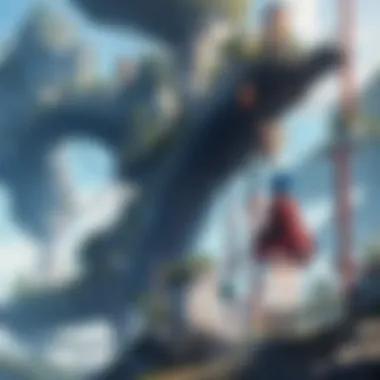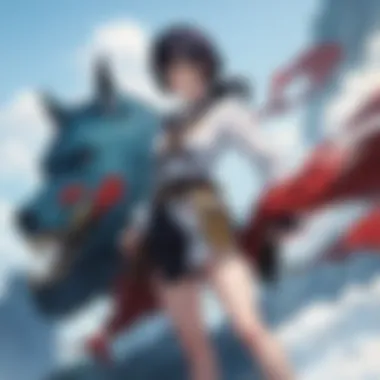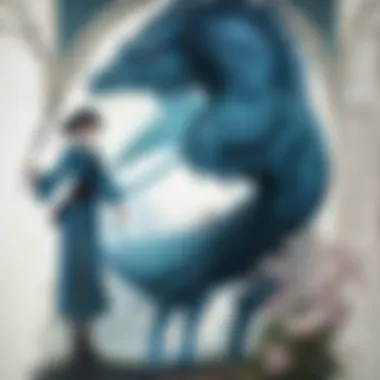An In-Depth Analysis of Hayao Miyazaki's Cinematic Legacy


Intro
Hayao Miyazaki is a name synonymous with some of the most remarkable animated films in cinema history. This introduction aims to provide an overview of Miyazaki’s films, their unique stylistic elements, and the anthropological lens through which they portray society, culture, and emotional experiences.
Miyazaki co-founded Studio Ghibli in 1985, rapidly shaping the landscape of anime. With memorable classics such as My Neighbor Totoro, Spirited Away, and Princess Mononoke, Miyazaki's thematic explorations address both personal and global issues. His films often encapsulate an idyllic relationship with nature juxtaposed against industrial advancement.
Release Dates and Genres
Miyazaki's films tell rich stories that belong to varied genres, ranging from fantasy to adventure and drama. Some important dates of his renowned works include:
- Castle in the Sky (1986)
- Nausicaä of the Valley of the Wind (1984)
- Howl's Moving Castle (2004)
Culminating these elements, he seamlessly presents overarching questions about human identity and environmental stewardship.
Popularity and Reception
Miyazaki's films have enjoyed widespread acclaim both in Japan and globally, with numerous awards acknowledging their extraordinary artistry. Notably, Spirited Away won the Academy Award for Best Animated Feature in 2003. The emotional depth and visual splendor of his films resonate with diverse audiences.
Public discussions point toward an impressive cultural footprint, with merchandise and adaptations expanding the horizons of fandom. However, what makes Miyazaki so compelling is not simply his popularity, but the unique balance he maintains in depicting intricate characters against rich world-building.
In summary, the films of Hayao Miyazaki serve not only as entertainment. They offer viewers an opportunity to ponder deeper questions about the environment, society, and the human condition. As we delve deeper into Miyazaki’s filmography, we uncover elements that exhibit his craftsmanship and storytelling prowess.
Preamble to Miyazaki’s Cinematic World
The exploration of Hayao Miyazaki’s cinematic landscape reveals the profound impact his films have on animation as a medium. His unique viewpoint continues to shape not only the narratives that unfold on screen but also the evolution of animation’s role in cultural storytelling. It is essential to highlight how his artistic contributions transcend simple entertainment; they instead serve as a narrative means to provoke thought, dialogue, and emotional connection. Miyazaki is not just an animator; he is a visionary who intertwines fantasy with pressing realities, making the thematic significance of his works worth studying.
Importance of Hayao Miyazaki in Animation
Hayao Miyazaki stands as a towering figure in animation history. His films have elevated the status of animated storytelling from mere children’s entertainment to a sophisticated cinematic art form. With notable works such as Spirited Away, My Neighbor Totoro, and Princess Mononoke, Miyazaki introduced dark, complex themes, making them accessible through childlike wonder. His framings of iconic scenarios deliver messages about environmentalism, pacifism, and the nuance of human emotions.
Moreover, Miyazaki has effectively blended techniques from traditional animation with modern storytelling methods. The intricate hand-drawn animations and detailed backgrounds in his films showcase an artistic craftsmanship rarely seen in contemporary animated features. This commitment to arts in storytelling influences animators worldwide to pursue authenticity and imagination.
Besides, Miyazaki has mentored a generation of animators, helping propagate the significance of storytelling through animation. He reminds audiences of the narrative potential within this medium, asserting that animation can tackle profound questions and cultural critiques. This attribute ensures his importance extends far beyond past works.
Overview of Studio Ghibli
Studio Ghibli embodies the might of Miyazaki's genius and ambition in creating a safe haven for storytelling. The inception of the studio in 1985 has forever altered the landscape of animation in Japan and beyond. With iconic co-founder Isao Takahata, Miyazaki crafted films that pushed creative boundaries while providing poignant critiques on social issues.
The studio's ensemble of unique stories often showcases strong female leads, intricate world-building, and an abiding respect for nature. Some exceptional films define Studio Ghibli, such as Totoro, embodying simplicity and magic while weaving intricate narratives.
Studio Ghibli has also gained immense international recognition and influence, reflecting an ideal blend of Eastern and Western influences while retaining cultural roots. By clearly recognizing social and environmental concerns, Studio Ghibli's mission stays aligned with Miyazaki's ethical compass, ensuring resonance not only with Japanese audiences but also globally, hence a pinnacle in modern cinema.
Studio Ghibli is not just an animation studio; it is a cultural institution cultivating creativity and inspiring innovators worldwide.
Through understanding Miyazaki's contribution within the context of Studio Ghibli's creations, viewers can realize the broader interplay between animation and culture.
Besides elevating the quality of narratives, the films also gather loyal fandom drawing from their charisma and authenticity. As the introductions unfold, engaging with Miyazaki’s cinematic world reveals treasures which can profoundly impact soulful journeys of continued exploration.


Thematic Depth in Miyazaki Films
The thematic depth in Miyazaki films opens various avenues of exploration. This section is vital as it highlights how Hayao Miyazaki intertwines complex issues into narratives that appear simple on the surface. His films are layered with meaning that resonates with audiences, encouraging them to reflect and dig done deeper into both personal and societal challenges. An appreciation of these themes not only enhances the viewing experience but fosters a greater understanding of his views on life, relationships, environmentalism, and more.
Environmentalism and Nature
Miyazaki’s films frequently echo themes of environmentalism. He deeply values nature and emphasizes its preservation. For instance, in
Distinctive Art Style and Animation Techniques
Hayao Miyazaki's films are distinguished not only by their compelling narratives but also by their unique art style and animation techniques. This aspect is crucial because it sets his works apart from contemporaries in the animation industry. A viewer can often identify a Miyazaki film instantly due to these distinct characteristics. Elements such as rich colors, meticulously crafted backgrounds, and expressive character designs all contribute to the enchanting experience that defines his work.
Influence of Traditional Japanese Art
Miyazaki's artistry deeply draws from traditional Japanese aesthetics. This connection is evident in many aspects, such as composition, use of space, and themes woven into his narratives. For instance, settings in movies like Spirited Away showcase a reverence for nature that mirrors classic Japanese artistry which looks to find beauty in the transient aspects of life. The meticulous detailing in the landscape echoes the fine brushwork commonly associated with ancient Japanese artists. This approach adds depth and cultural relevance to his films, allowing audiences to connect with them on another level.
By honoring the nuances of traditional art, Miyazaki creates a seamless blend with modern storytelling that respects the past while shaping the future of animation.
Character Designs and Aesthetics
Miyazaki's character designs are often complex yet engaging, realized through a nuanced understanding from the perspectives of various audiences. Characters are designed with distinct features that contradict typical animation archetypes. This includes large, expressive eyes that convey a spectrum of emotions. Postures and shapes also play a significant role; for example, the rounded silhouettes of characters like Totoro project warmth and friendliness, while sharper lines in certain antagonists may suggest the opposite.
The designs help to capture the essence of each character's personality and their journey throughout the film, adding not only visual appeal but also depth to the narrative. Mirroring authentic human emotions helps make his characters relatable, transcending the boundary that usually separates animated figures from real life.
Innovative Use of Color and Light
Miyazaki’s films are known for their vibrant use of color and inventive light techniques, deeply enhancing the viewing experience. Color palettes are often used strategically to evoke mood and reinforce themes. For example, darker tones hint at adversity while warmer tones foster feelings of hope. In My Neighbor Totoro, the lush greens of the rural landscape embody vitality, highlighting nature’s beauty and significance.
Moreover, the way light and shadow are manipulated anis incredibly innovative. Light plays a crucial role in scenes, guiding the viewer’s attention or providing context to emotional moments. By incorporating changes in light dynamically, the storytelling gains an additional emotional layer, encouraging audiences to reflect on the message the scene conveys.
Miyazaki's films illustrate how technical elements in animation greatly influence storytelling, allowing viewers to engage more deeply with the themes and narratives.
Understanding these distinctive artistic techniques is essential for appreciating the full depth of Miyazaki’s work. Animated films are more than mere storytelling; they are a study of artistic expression that resonates across cultures. His attention to detail in creating visuals that support complex narratives has established Hayao Miyazaki as a pivotal voice in the world of animated cinema.
Character Analysis in Key Films
In the world of Hayao Miyazaki's cinema, character analysis is a key essential. Understanding his characters allows for deeper insights into the thematic elements and narrative structures that define his works. Each character serves not merely as a narrative device, but also as an exploration into the complexities of human experience.
Protagonists and Their Journeys
Miyazaki’s protagonists recelve focus, resonating with audiences on various emotional levels. Noteworthy examples include Chihiro from Spirited Away and Sophie from Howl's Moving Castle. Their journeys are rarely just physical expeditions; they are profound explorations of self-discovery.
- Chihiro transitions from a frightened child into a brave, resourceful individual.
- Sophie learns to embrace her identity and realizes her own strength despite feeling undervalued.
Through these narratives, Miyazaki illustrates that characters can choose their paths, evolving in ways that reflect their inherent virtues and flaws. Life is painted as a tapestry where growth emerges through resilience in adverse circumstances.


Antagonists and Their Motivations
In Miyazaki's films, antagonists often possess depth, which makes them compelling. They are not simply
Narrative Structures and Storytelling Techniques
In the realm of Hayao Miyazaki's filmography, narrative structures and storytelling techniques stand as pillars supporting the intricate worlds he creates. His storytelling not only captivates audiences but also invites deeper reflection on complex themes. By employing specific narrative techniques, Miyazaki weaves rich tapestries of human experience, revealing insights into personal and collective journeys. This section dissects those pivotal elements that contribute to the storytelling prowess witnessed in Miyazaki's films.
Mythological Influences on Storytelling
Miyazaki adeptly incorporates mythological influences into his narratives, grounding them in a sense of cultural depth and significance. Drawing from various traditions, including Shintoism, he often presents divinity and nature in his stories. In Princess Mononoke, the struggle between industrialization and nature echoes myth themes; the forest spirits embody age-old beliefs. This sense of mythologization enables the portrayal of spiritual elements while also exploring human emotions.
Considerable attention is paid to how myth informs character motivations. Protagonists frequently embark on quests resembling legendary heroes, creating a familiar connection for viewers. The presence of mythical creatures and deities not only adds wonder but serves as a vehicle for expressing universal concerns, like environmental degradation.
Non-linear Narratives and Their Purpose
Miyazaki’s storytelling avoids the constraints of linear narratives. Instead, he often opts for non-linear plots that challenge viewers to engage with the material on a cerebral level. Films like Spirited Away exemplify this approach. The journey unfolds not in a straight line but rather circles back on itself, echoing the complexity of human context and perspective. This allows themes to percolate throughout the film, beckoning discussions that linger long after viewing.
Non-linear narratives also facilitate character development by revealing texture in relationships and parallels between past and present. The characters evolve, showing that personal growth does not adhere to customary timelines. This structure mirrors real-life experiences, where lessons emerge over time, leading to richer storytelling.
The Role of Folklore in His Works
Folklore sustains a prominent role in Miyazaki's cinematic universe. His films often reference traditional stories and narratives prevalent within Japanese culture. By embedding these tales into his plots, he honors collective psyche while simultaneously modernizing ancient narratives that feel vibrant and relevant. Films like My Neighbor Totoro showcase folktales forming frameworks for understanding loss, companionship, and the interconnectedness between humans and nature.
Furthermore, folklore enables layers of interpretation. Citizens are often reimagined from such tales, offering alternative perspectives on familiar situations. The recurring themes resonate across cultural divides, persuading audiences to engage with moral dilemmas and ethical questions characteristic of the human condition.
Folklore not only enriches narratives but creates a bridge linking generations and cultures, allowing diverse audiences to connect through shared human experiences.
Miyazaki’s narrative techniques together clearly outline the exceptional artistry of his films. They reveal strict attention to emotional authenticity and a profound respect for cultural heritage, leaving viewers with narratives that resonate long after a film has ended.
Cultural References and Social Commentary
Cultural references and social commentary within Hayao Miyazaki's films provide a vital lens through which to analyze his work. These elements not only depict the intricacies of Japanese culture but also explore broader human experiences and societal issues. Miyazaki skillfully weaves specific cultural references deeply into his storytelling, creating films that resonate with various audiences globally, despite cultural differences. His attention to social themes encourages viewers to reflect on their values, ethics, and responsibilities.
Reflection of Japanese Society
Miyazaki’s films often reflect core aspects of Japanese society, such as the connection to nature, the concept of community, and the influence of folklore. In Spirited Away, for instance, the bathhouse and its denizens pay homage to Japan's traditions, showcasing a society where spirits and humans coexist. Themes of industrialization also arise—expressing a critical view towards modern life. The stark contrast between rural landscapes and emerging urbanism illustrates a struggle familiar in contemporary Japanese society. These reflections invite audiences to ponder Japan's shifting identity in the modern world.
Moreover, typical societal roles especially in familial structures make strong appearances in his narratives. In My Neighbor Totoro, we see a depiction of childhood innocence in a rural setting defined by family bonds, illustrating Japanese values of togetherness and simplicity. The modernization phased within films questions traditional beliefs while blending in the magical realism Miyazaki is known for.
Universal Themes and Global Appeal
While intrinsically tied to Japanese culture, the themes presented in Miyazaki's films transcend cultural boundaries, appealing to viewers worldwide. Universal themes like love, loss, courage, and resilience resonate on a human level. Films such as Princess Mononoke tackle environmental issues that are relevant globally, stressing the connection humans have with nature, and pushing the message towards ecological conservation fit for international conversations.
Key universal themes in Miyazaki’s storytelling include:


- Friendship and Loyalty: Seen prominently in Kiki’s Delivery Service, showcasing bonds that overcome obstacles.
- Coming of Age: Films like Howl's Moving Castle exemplify characters facing inner challenges and self-discovery.
- The Battle Between Good and Evil: Nausicaä of the Valley of the Wind exemplifies moral dilemmas that everyone can identify with.
Miyazaki weaves these themes skillfully throughout his films as he considers the larger sociopolitical messages aimed towards conservation and humanity's place in the world. This unique fusion of solid cultural insight, presented with universal themes, encourages a wide-ranging appeal and makes many of his films realistic, relatable, and timeless, bridging gaps across generations and cultures.
As a result, Miyazaki's works not only entertain but also stimulate discussions of critical societal issues that many nations face, thus cementing his legacy as a profound thinker in animation and film.
Miyazaki’s Legacy and Influence in Contemporary Animation
Hayao Miyazaki's influence in the world of animation extends far beyond his distinctive films. His contribution significantly shaped the genre, inspiring countless individuals in the field. As a creator, his work encompasses complex themes and profound storytelling that remains™ relevant in today's media landscape. Miyazaki's unique vision consistently champions creativity and emotional depth, allowing current and future creators to find their own paths within animation.
Mentorship and Impact on New Generations
Miyazaki's role as a mentor has been pivotal. Many animators and filmmakers credit him for encouraging them to pursue their artistic visions. For instance, prominent figures such as Mamoru Hosoda and Hiromasa Yonebayashi have spoken about the importance of Miyazaki's openness in sharing knowledge and nurturing talent. Nishimura Yoshiaki, a seasoned producer, has observed how Miyazaki's values resonate deeply with emerging creators.
In recent years, many of the students of his animation school, Ghibli Institute, have expanded into the industry. This reflection not only honors legacy but also showcases the vitality of Miyazaki's teachings. Mentoring promotes further creativity and innovation, proving vital for a thriving animation ecosystem. This cascade of inspiration births new ideas, preserving Miyazaki’s ethos and evolving it within contemporary narratives.
Miyazaki’s Works in Popular Media
Miyazaki’s films have transcended their initial releases, finding enduring acclaim in various forms of media. Collaborations and adaptions proliferate, allowing his stories to reach wider audiences. Notable movies like Spirited Away and My Neighbor Totoro continue inspiring various formats including video games and merchandise, firmly establishing their influence in popular culture.
While Gaijin-animated films draw elements from Miyazaki's work, there are other notable inputs to modern cinema, such as:
- Direct reference to character designs and moral themes in animated series.
- Integrating Ghibli-approved content in classroom learning materials, nurturing appreciation for the nuanced philosophies within Miyazaki's films.
In addition, stream platforms like Netflix showcase Studio Ghibli's works, ensuring accessibility for a global audience. This availability allows experimentation, enhancing their cultural relevance beyond initial contexts. Modern influences in anime also cite him as a benchmark for quality, both artistically and narratively.
"Lessons from Miyazaki reveal how richness of stories coalesce with artistry, transcending the barriers of time and cultural philosophies."
All these influences make the legacy of Miyazaki not merely historical but rather as evolving foundations within global animation contemporary frameworks.
Finale: The Enduring Impact of Miyazaki Films
The conclusion of Miyazaki's impact in the world of cinema is critical. It serves to summarize the insights gathered throughout the article and highlights the unique qualities of his films that resonate even today. His work has significantly influenced not only animation but also broader cultural narratives. The meticulous detail in character design, storyline, and visual elements all convey deeper meanings, which continue to evolve with time.
Reflection on His Contribution to Cinema
Hayao Miyazaki's contributions to cinema are vast and multifaceted. He redefined animation by merging whimsical narratives with serious themes that address human emotions, environmental concern, and societal values. His approach discloses a sensitivity to diverse experiences which broadens the scope of storytelling in a medium often dismissed as frivolous. The emotional authenticity in films like Spirited Away showcases how animated stories can challenge adult perspectives and evoke visceral responses.
More than just devastated childhood myths or fight against cultural negativity, he broadens the lens through which animation can be viewed. He introduced femininity leading roles through Kiki's Delivery Service and Nausicaä of the Valley of the Wind, normalizing a diverse set of characters.
His stories exhibit in-depth world-building, such as presented in Howl's Moving Castle. The contexts in which these characters exist often reflect Miyazaki's values, suggesting peaceful coexistence and resistance to conflict. Films like Princess Mononoke draw straight from ecological themes, further cementing Miyazaki's legacy as a visionary who brought pressing issues to mainstream cinema.
The Future of Animation Inspired by Miyazaki
Miyazaki's works will overwhelmingly influence future generations of animators and storytellers. His dedication to preserving imagination over corporate interests sets a precedent that many aspiring creators admire. Studio Ghibli, which he co-founded, continues to mentor new talent, fostering an environment where creativity can flourish.
As we see technological advancements revolutionizing animation, his essence can still be felt in works that prioritize story over spectacle. New filmmakers are increasingly embracing hand-drawn techniques reminiscent of Miyazaki’s style. They aspire to maintain the deep emotional connections that his films cultivate. His ideals cannot be understated. Each animation project undertaken today reflects part of his thoughtful narrative
"Animation offers a deeper, truer door to the emotional, the dream and the visual."
As the medium continues to evolve, we can observe a complex relationship between technology use and authentic storytelling practices. Projects like Spider-Man: Into the Spider-Verse borrow heavily from enriching character development and phenomenon conceptualization witnessed in Miyazaki's works. Audience preferences are shifting slightly to a demand for narratives that hold merit beyond entertainment.















